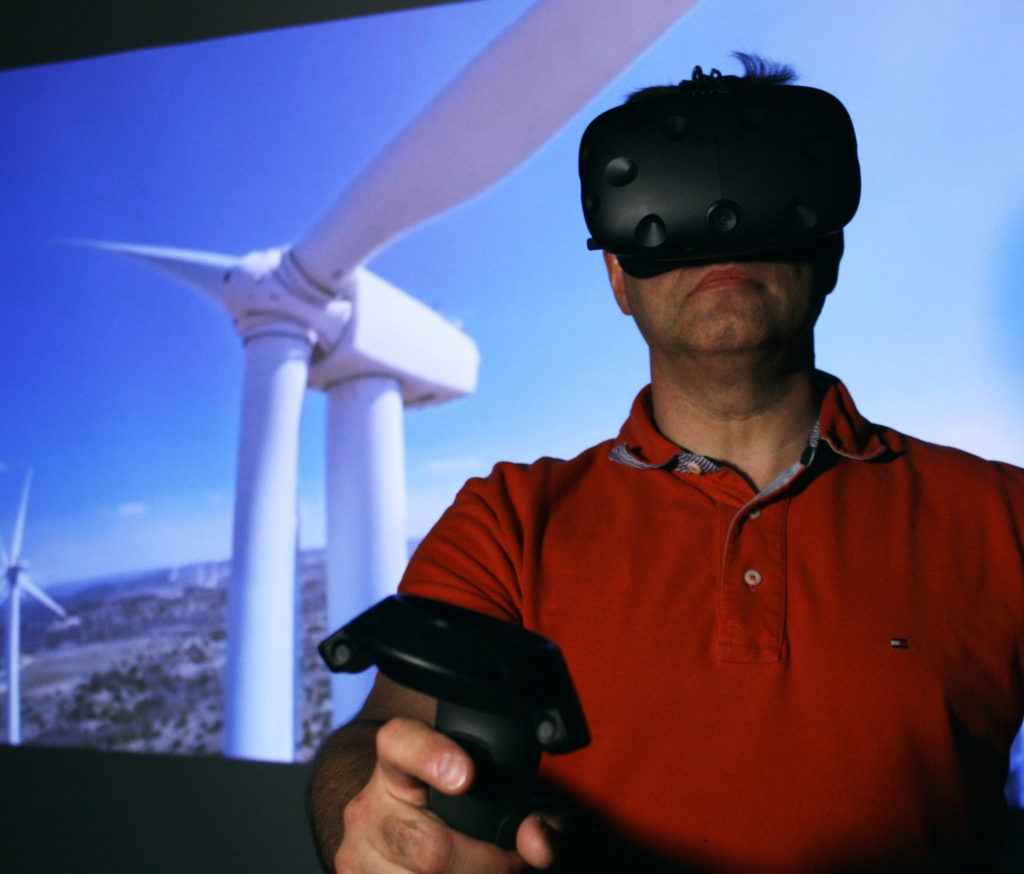
TUT’s/SeAMK’s part of the project is related to social acceptance through virtual reality models.
Virtual reality tools enable communication and even co-design of the wind power parks between designers and local inhabitants, who often have overestimated fears related to visual impacts of the park.
In this project we study how visualization of a becoming wind park will effect on social acceptance of local people. Wind park model will be visualized from the actual locations of local people in order to show how the wind park will change environment from their home yards.
Generally, people do not have access to wind power parks. Wind power park owners do not arrange open door days to the general public. People may have strong opinions on wind power parks, both for and against, regardless of whether they live close to one or if they have ever seen one. There are however some methods to make people acquainted to the wind power parks and their environmental effects by the use of Virtual Reality (VR), enabling people to visit a virtual wind power park. These methods comprise of hardware, software and the digital model. There are also some very cheap methods that people may try at home without purchasing expensive VR equipment. Normal smartphone equipped with a cardboard VR headset and headphones will provide the first step into a virtual wind power park.
There are several technologies, designs and topologies within virtual reality displays. Curved screens are usually preferred choices in simulator use where it is important to cover the horizontal field of view of the user but the sense of depth comes mainly from visual cues and therefore stereoscopic viewing is not necessary. Angled screens are just a cheaper method to achieve the same effect with some visible borders in the image. Display domes are typical for panoramic views of sky, planetariums and IMAX theaters. Stereoscopic display walls are common in large venue presentations but offer poor immersion. Immersive desks are used mainly in CAD design and medical applications. Cubic VR display rooms such as a CAVE (Cave Automatic Virtual Environment) enable viewer to walk inside the display cube and provide a good immersion with fast tracking of viewer’s head movements. Head mounted displays (HMD’s), also called VR headsets, render separate images for viewer’s left and right eye providing full stereoscopic view and perfect sense of depth. Fast head movement tracking is even more essential in this technology. HMD’s and virtual rooms such as CAVEs provide currently the best immersive effect to the user, and therefore those methods may be used in the WindCOE project.
The main differences between CAVE and HMD are in transportability, price, level of immersion, sense of presence, isolation from real world, feasibility for group work, wireless/tethered technology, operational area, resolution and comfortability.
HMD software falls into two categories. The first one will provide a method to render a three dimensional digital model for the viewer in a way that allows the viewer to achieve a full 360-degree field of view. The viewer may move physically within an area of approximately 5 m x 5 m with tethered computer equipment and navigate freely around the virtual wind power park environment using navigation equipment. The impact of this model relies on the realism provided by modeling and rendering techniques used generally in modeling software and game engines. This method will give a chance to add behavior to the model with interactivity and actions triggered by the viewer.
The second one doesn’t allow the viewer to navigate freely, but gives much more realistic appearance to the viewer. It doesn’t provide methods of interaction either. This method is based on 360-degree immersive video, which can be viewed with a VR headset. The video material is recorded on site with a special 360-degree camera, which captures a spherical image and records or transfers that image projected on a flat surface, which is later wrapped back to spherical display surface. The 360-degree cameras are generally quite light and the video material can be recorded on memory chip.
Software for the CAVE must be stereoscopic multi-display software supporting accurate user’s head and control device tracking and provides a visual and aural feedback for the user’s perspective in three dimensional model. Since this kind of software programs are very expensive, it must be considered carefully, which software will be used for CAVE visualization, testing and possible reviews. The WindCOE project provides an opportunity to investigate different options for the software, focus being on existing, already licensed software.
Digital model of the wind power park is either accurate three dimensional model created with a 3D modeling software, or a 360-degree video captured on location, depending on the rendering equipment described above. Since a wind power park is a large area to be modeled properly and in a realistic way, special and modern methods are needed instead of traditional manual modeling. The WindCOE project provides an opportunity to study different methods in creation of the 3D model of a wind power park. One of the most promising technology in highly automated level of 3D model creation is photogrammetry based 3D modeling. Another method is 3D model creation based on laser scanning.
The most challenging modeling task is the aural simulation.
Tapio Hellman, Seinäjoki University of Applied Sciences
